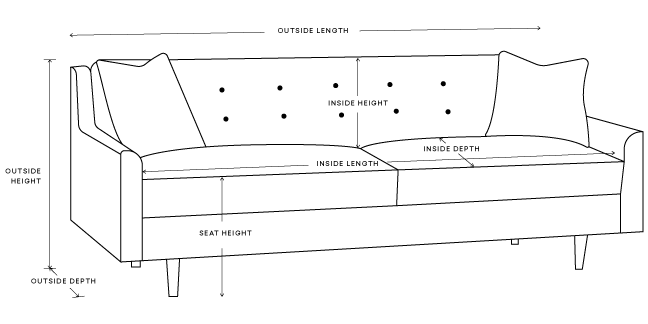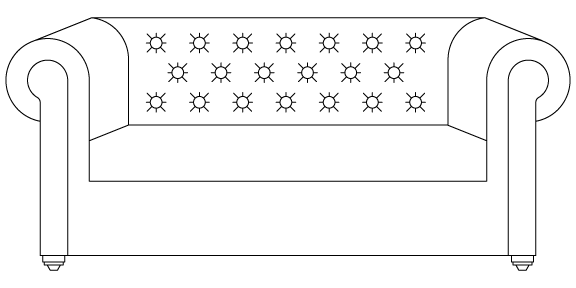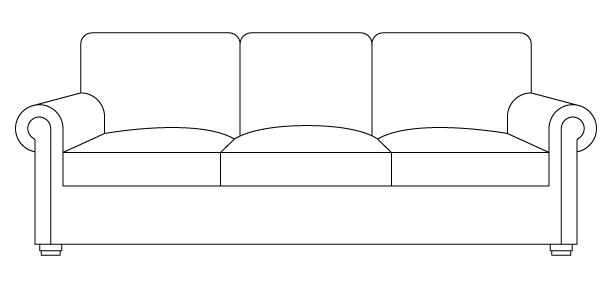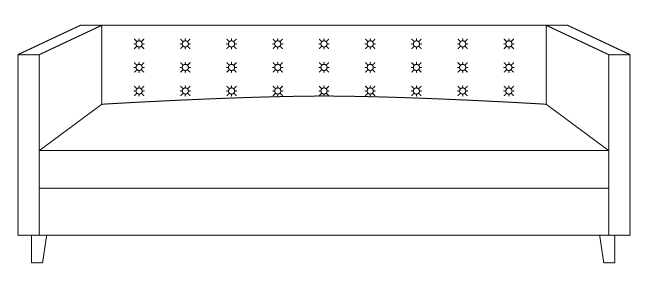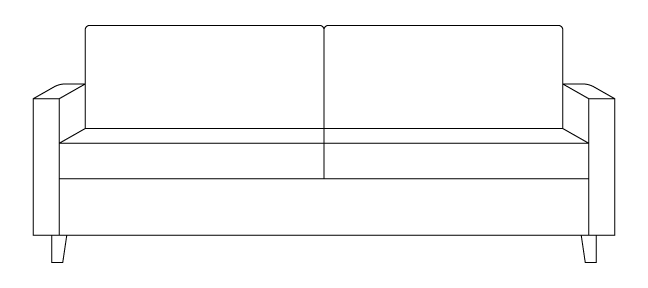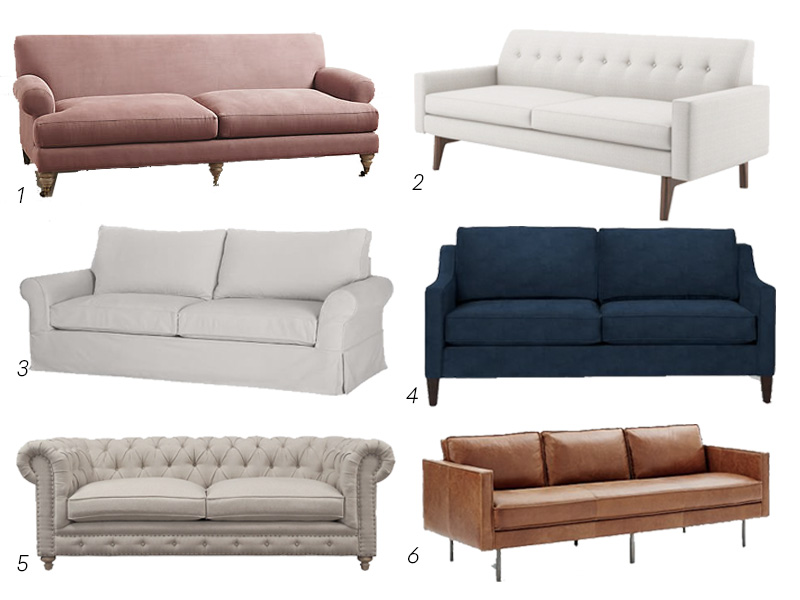Let’s face it — sofa shopping is overwhelming and can also be exhausting, especially without the proper prep work and research. More often than not, living rooms and family rooms are built around this central piece of furniture, so that means there’s a lot of pressure to get it right.
As designers we start by asking ourselves a series of questions and doing a bit of research before diving in: Who will be using the sofa? Will it be a crash-pad when the kids get home from school, or is it strictly for entertaining? Do you want to melt into the cushions for movie night, or sit upright when reading a book or your favorite magazine? Is the sofa going to give your room that “wow-factor” you’re looking for, or is it meant to be the neutral building block of your design?
But wait! Before you pull out your pocketbook for this big-ticket item, you have a bit of homework to do. We’ve compiled a complete guide discussing everything from materials and construction to style and usage considerations to make your decision a bit easier.
Sofa Shopping Guide
Materials
Frame Materials: most sofa frames are made from wood, but some have metal frames. Here’s a rundown of the most common frame types used in sofas:
- Particle Board – Cheapest, most fragile, lightest construction material made of composite wood materials. Also the most inexpensive.
- Hard Wood – Usually Oak, Cherry, Walnut, Beech, Alder. Hard wood frames are made out of solid wood—much more durable than particle board.
- Kiln Dried Hardwood – Kiln Drying is a finishing process for the wood where they dry the wood in large ovens, which makes the wood much stronger and more durable. Least likely material to warp or snap.
- Metal – Hardest frame material but can bend over time, and will not snap.
Fabric Types
Different types of materials have different characteristics, like strength, durability, stain resistance, and cost. Some fabrics are more fade and mildew resistant than others. Fade resistant fabric is best if the sofa will be standing in direct sunlight. Mildew resistance is desirable in a humid climate. Generally speaking, synthetic fibers are more resistant to everyday wear and tear than most natural materials.
Natural Materials
Natural materials have always been a popular choice for sofa upholstery. The table below lists a number of natural fabrics with a brief description of each.
Fabric Type |
Description |
|---|---|
| Leather | Leather is one of the most popular sofa materials. It is strong and durable, easy to clean, and develops character over time. Also, few things can compare to the luxurious feel of soft leather, and leather becomes softer and more comfortable as it ages. Because it is easy to clean and not affected by shedding pets, leather is often recommended for people with pets and younger children. However, leather does not stand up well to sharp objects. It can be damaged quite easily by pets’ claws or metal edges, and tends to feel sticky in hot or humid weather. Genuine leather is also a higher quality material, so leather sofas are generally more expensive than their upholstered counterparts. |
| Cotton | Cotton is not as stain resistant or durable as synthetic materials. Depending on the tightness of the weave, cotton can be prone to damage and wrinkling. A tighter weave produces a stronger fabric. Textured cotton is a popular choice for sofas in quieter locations, and cottons tend to become softer over time. Although it looks good, it wears fast and tends to trap dirt in the grooves in the fabric. |
| Linen | Linen has similar characteristics to cotton. While it is not the most durable fabric, it is handsome and a great option for homes without small children and pets, or for sofas used in more formal settings. Linen is a high-maintenance fabric, as it is prone to wrinkling and stretching, and typically requires professional cleaning or dry cleaning. |
| Wool | Wool is durable and beautiful, but more expensive than other fabrics and fairly rare as sofa upholstery. It is easy to clean and care for, and has natural wicking properties so spills will sit on the surface rather than being absorbed into the material. Wool is also hypoallergenic and great in humid climates. |
| Silk | Silk is smooth and sleek, but fragile. It is difficult to maintain, but is elegant and rich making it perfect for a room that is not used often. Even though it is a wrinkle-resistant material, it is not recommended in high-traffic areas. |
A sofa’s lifespan can be lengthened by adding a slip cover or throw in order to protect the upholstery. You should also rotate and flip the sofa cushions every 3-6 months to allow for even wear and tear during the lifespan of the sofa.
How to Care for Natural Fabrics
Linen: Linen is best suited for formal living rooms or adult-only areas because it soils and wrinkles easily, and it won’t withstand heavy wear. However, linen does resist most pilling and fading. Soiled linen upholstery must be professionally cleaned to avoid shrinkage.
Leather: This tough material can be gently vacuumed, damp-wiped as needed, and cleaned with leather conditioner or saddle soap.
Cotton: This natural fiber provides good resistance to wear, fading, and pilling. It is less resistant to soil, wrinkling, and fire. Surface treatments and blending with other fibers often atone for these weaknesses. Durability and use depend on the weave and finish. Cottons and cotton blends can be spot-cleaned when necessary, although professional cleaning is encouraged to avoid shrinkage of the material.
Wool: Sturdy and durable, wool and wool blends offer good resistance to pilling, fading, wrinkling, and soil. Generally, wool is blended with a synthetic fiber to make it easier to clean and to reduce the possibility of felting the fibers (causing them to bond together until they resemble felt). Blends can be spot-cleaned when necessary.
Cotton Blend: Depending on the weave, cotton blends can be sturdy, family-friendly fabrics. A stain-resistant finish should be applied for everyday use.
Vinyl: Easy-care and less expensive than leather, vinyls are ideal for busy family living and dining rooms. Durability depends on quality. Vinyls can be spot-cleaned when necessary.
Silk: This delicate fabric is only suitable for adult areas, such as formal living rooms. It must be professionally cleaned if soiled.
Blends and Synthetics
The table below lists synthetics and synthetic blends, with a short description of each.
Fabric Type |
Description |
|---|---|
| Microfiber | Microfiber is a type of very fine polyester that is soft but durable, easy to clean, and competitively priced. It is extremely closely woven and does not allow pet hair to stick to it. Those with allergies should consider fabrics like microfiber, which does not attract dust and is lint free. |
| Faux Leather | Faux leather is a popular choice for those whose consciences do not allow them to take home real leather. It is more resistant to pets than the real thing and just as durable, looks just as rich and luxurious, but is less expensive and kinder to animals. |
| Chenille | Chenille also looks elegant and it is stronger than other fabrics. It can be made from cotton, but is often created from synthetic materials like rayon or olefin. |
| Acrylics | Acrylic fibers resemble wool and are soft to the touch. They are very durable, and stain, wrinkle, and fade resistant, as well as affordable. |
| Rayon | Rayon can be manufactured to closely resemble cotton, linen, or silk. It is relatively fade resistant, but prone to wrinkles. |
| Polyester | Polyester is one of the most widely used synthetic materials because it is wrinkle resistant, very strong, and easy to clean. |
| Olefin/ Polypropylene | Olefin and polypropylene have excellent stain and mildew resistance. Both materials are durable and priced competitively. |
Synthetics can imitate most natural fabrics and are generally easy to clean, and are often completely resistant to stains. While cotton and linen can be treated to improve stain resistance, these fabrics are still not as easy to clean or as strong as synthetics. Blends of synthetic and natural fibers have a tendency to pill after a short while, but may be more resistant to wrinkling and fading. Synthetics used in blends include polyester, acrylics, olefin, and vinyl, with cotton and polyester blends being most popular. The addition of polyester makes the cotton more durable and wrinkle resistant, making them appropriate for everyday use.
How to Care for Synthetic Fabrics
Acetate: Developed as imitation silk, acetate can withstand mildew, pilling, and shrinking. However, it offers only fair resistance to soil and tends to wear, wrinkle, and fade in the sun. It’s not a good choice for furniture that will get tough everyday use. Must be professionally cleaned.
Acrylic: This synthetic fiber was originally developed as imitation wool. It resists wear, wrinkling, soiling, and fading. Low-quality acrylic may pill excessively in areas that receive high degrees of abrasion. High-quality acrylics are manufactured to pill significantly less.
Nylon: Rarely used alone, nylon is usually blended with other fibers to make it one of the strongest upholstery fabrics. Nylon is very resilient; in a blend, it helps eliminate the crushing of napped fabrics such as velvet. It doesn’t readily soil or wrinkle, but it does tend to fade and pill.
Olefin/Polypropylene: This is a good choice for furniture that will receive heavy wear. It has no pronounced weaknesses. Olefin and polypropylene can be cleaned with most over-the-counter household cleaners.
Polyester: Rarely used alone in upholstery, polyester is blended with other fibers to add wrinkle resistance, eliminate crushing of napped fabrics, and reduce fading. When blended with wool, polyester aggravates pilling problems.
Rayon: Developed as an imitation silk, linen, and cotton, rayon is durable. However, it wrinkles. Recent developments have made high-quality rayon very practical. Professional cleaning is encouraged, as rayon does not always respond well to water or water-based cleaners.
Construction
Seat Cushion Types
Low Density Foam: least expensive, soft to the touch, most likely to flatten, dimple, and lose its shape faster.
High Density Foam: mid-range price, firmer sit, and holds its shape longer than low density foam. Often paired with a down or down-alternate wrap to create a more plush cushion
Down: filled with goose down, most expensive, and most comfortable option. Cushions need a bit more maintenance and need to be fluffed regularly to maintain their shape. Can also cause allergies if consumers are allergic to feather products.
Hybrid cushions: mixtures of foam and down create a soft, plush sit with the stability of a foam cushion and comfort of a down cushion. Price point is usually similar to a high-density foam
Back Cushion Types
Pillow Back: loose/removable cushions allow easy removal for cleaning, sleeping, and fluffing/rotating as needed. Loose cushions may lose shape if they are not regularly fluffed
Tight Back: cushions are sewn on to the frame, so there’s no need to worry about cushions shifting over time. These can be trickier to clean, and do not allow for even wear.
Frame Construction
Eight-way Hand Tied: considered the “best” construction method as it prevents sagging, is the most durable, and most comfortable method. However, it is also the most expensive. In this process, steel bands are stretched under strips of webbing and double nailed to the frame to give the necessary foundation for the spring chamber. The tempered steel coil springs are then tied by hand at eight points for ultimate strength and comfort
Sinuous Spring: Sinuous springs are two-dimensional “S” shaped wires that run from the front rail to the back of the seat, spaced every few inches. This option is often less expensive than an eight-way hand tied sofa, and is ideal in a contemporary sofa since it requires less space in the frame.
Web Suspension: Bands of webbing two to three inches wide cross the seat and back, and are tacked to the sofa frame to create a hammock-like platform for cushions. This is considered the least preferable construction method since it does not have a long lifespan, but is often the least expensive.
Sofa and Loveseat Sizes
Sofa: An average sofa measures 86 inches wide (length), 38 inches deep, and 37 inches high. Generally, a sofa will fall somewhere between 33-42 inches high; 35-44 inches deep; and 76-90 inches wide. However, overall dimensions are not the only measurement to consider. The inside depth (or seat depth) will play a large factor in the comfort level of a sofa. If you are petite, consider a seat depth that falls around 19-21 inches deep; if you are tall, a seat depth of 22-24 inches will feel much more comfortable.
Loveseats: Generally, a loveseat measures 48-66 inches wide, 28-30 inches deep, and 35-37 inches high. The guidelines for seat depth are the same as those for a sofa.
Space and Measurements
Arrange your existing furniture, then measure the space available for the sofa. Measure the length and width of the sofa. Allow a minimum of 30 inches for any walkways around the sofa for walking around the room. If you use a coffee table, allow an additional 12 to 18 inches between the coffee table and the sofa, plus the width of the coffee table.
Visual Appeal
A large room with a standard 8-foot ceiling would look great with a long and wide, low-back sectional, while a small room with a 10- to 12-foot ceiling would be better suited for a loveseat with a high back. Before making a purchase, be sure it can get through the doors and hallways leading to the space!
Your Lifestyle
How Many People Do You Want to Seat?
That might sound like a silly question, but the truth is, nobody likes sitting on the crack between cushions on a sofa. So if you get a sofa with two cushions, expect just two people to use it. To accommodate more people, get a sofa with three cushions or a single long cushion, called a bench cushion. To maximize seating, consider a sectional sofa if you have adequate space for it!
When it comes to chairs, it is almost assumed that they are meant to seat just one person. However, there are quite a few over-sized chairs or “chair and a half” options that could potentially seat two people! These are great for use in bedrooms, family rooms, and entertainment rooms or home theaters.
Style and Other Considerations – Sofas and Loveseats
Sofas can be divided into a few basic styles: Chesterfield, English Roll Arm, Lawson, Tuxedo, and Track Arm. There are many, many other styles, but these are the most common styles.
Chesterfield sofas are easily identified by the deep button-tufting on the back, and rolled arms which are the same height as the back of the sofa. Chesterfields are typically upholstered in leather, and feel right at home in formal spaces.
English Roll Arm sofas are defined by the rounded arms, loose seat cushions, and tight back cushions. These sofas often have a skirted base, too.
Lawson sofas are similar to the English Roll Arm, but are identified by their loose back cushions. Although the arms are not always rounded, this is the most common style seen in a Lawson sofa.
Tuxedo sofas are similar to the Chesterfield in the sense that the arms are the same height as the back, but the silhouette of a Tuxedo sofa is much more clean-lined and geometric. Tuxedo sofas are not always button-tufted, but it is a very common feature.
Track Arm sofas are characterized by their square (or straight) arms, and generally clean-lined silhouette. Track arm sofas are often found in mid-century design, but they are a great fit for many design styles.
When to Replace
Standard upholstery warranties are usually up to two years for the upholstery, and up to four years, five years, or even lifetime on the frame. There are many components to consider when determining the lifetime of a sofa or chair, but it is safe to assume that an inexpensive, lower-quality upholstered item will last 3-5 years; a mid-range upholstered item could have a lifetime of 5-9 years; and high quality upholstered items could see a lifetime of 10+ years.
Havenly Recommends
Before you make your final decision on this big-ticket item, you have a bit of homework to do! Picking a sofa should start with a series of questions: Who will use it? Will it be a crash-pad when the kids get home from school, or is it strictly for entertaining? Do you want to melt into the cushions for movie night, or sit upright when reading a book or favorite magazine? How often do you replace your furniture or update your home design? Here are a few hypothetical scenarios, along with some of our sofa recommendations.
For those who are looking for more of a relaxed, lounging sofa, we recommend a sofa with:
- A sturdy frame – either solid hard wood or kiln-dried hardwood
- An upholstery with a long lifespan – a polyester or acrylic blend would be a great place to start!
- Consider a deep seat cushion (22-24 inches in seat depth) for maximum comfort and lounging
If formal entertaining is more your speed, look for a sofa with:
- Tight back cushions and an elevated height greater than 37 inches to encourage you and your guests to sit upright during dinner party conversations
- Two cushion and bench cushion sofas are great for formal entertaining, too! Both styles promote face to face interaction
- Cottons, linens, and even leathers are great upholstery options for a formal sofa! These materials add a sense of elegance and will not wear quite as quickly in an entertaining space
Style Glossary
Style |
Description |
|---|---|
| Box Cushion | cushion with four sides connecting the top and bottom. A welt frequently runs the perimeter of the top and bottom. |
| Button Tufting | upholstery treatment in which buttons (usually fabric-covered) are sewn through the surface and tied down to create a tailored, sometimes undulating, surface. |
| Chaise | a long chair for reclining; may have one arm, two arms or no arms at all |
| Channel Back | an upholstered chair or sofa back having deep vertical grooves. |
| Charles of London | style of arm on upholstered furniture which is low at the back and slightly raised and curved at the front. The inside of the arm is usually well padded and curves over the edge of the arm in the front, contrasting to a flatter treatment on the outside of the arm. |
| Chesterfield | overstuffed couch or sofa with upholstered ends and no exposed wood. Back and arms are usually of one continuous curve. |
| Down-Proof Ticking | a tightly-woven, inner lining of a cushion that prevents the migration of tiny feathers to a cushion’s exterior. |
| Loose Back Sofa | sofa with the same number of back cushions as seat cushions, but are not attached to the sofa body. |
| Rolled Arms | arms on upholstered seating that curve outward into a rounded form, extending horizontally beyond the supporting post. |
| Sectional | upholstered seating consisting of two or more sections arranged together (and sometimes joined through brackets) to create a larger piece. Frequently sectionals incorporate a directional change, forming the shape (when seen from above) of an “L” or “U”. |
| Settee | small sofa or loveseat with exposed, wooden legs. |
| T-Cushion | cushion of an upholstered sofa, loveseat, or chair on which the arms are set back from the front edge; the cushion extends from the from edge of the seat to the front of the arm. The resulting outline is in the shape of a letter “T”. |
| Tête-à-Tête | a small bench with an s-shaped back that crosses the seat that allows two people to sit facing each other. Also known as a courting bench. |
| Tight Back Sofa | sofa with the back cushions attached to the body of the sofa. |
| Top-stitching | a single or double row of stitching close to the seam or edge on the outer side of the fabric. |
| Tuxedo Arms | slightly flared arms that are the same height as the back |


